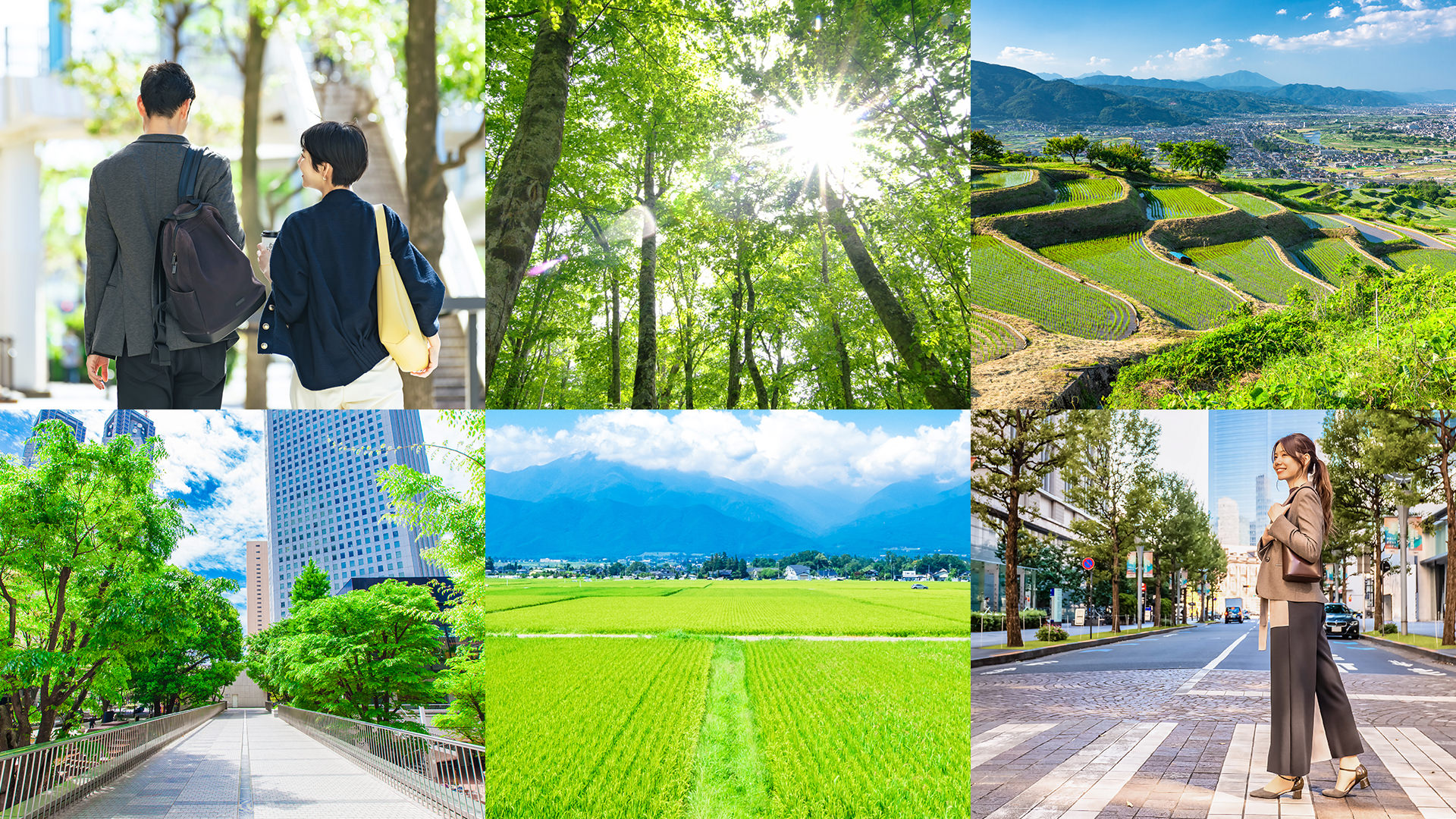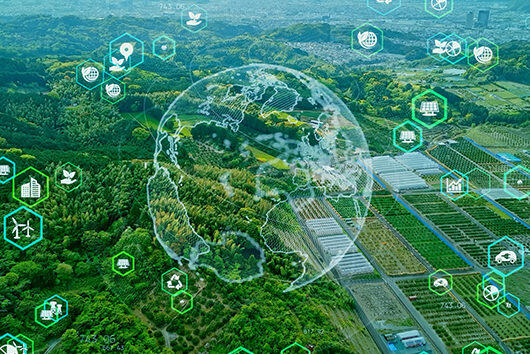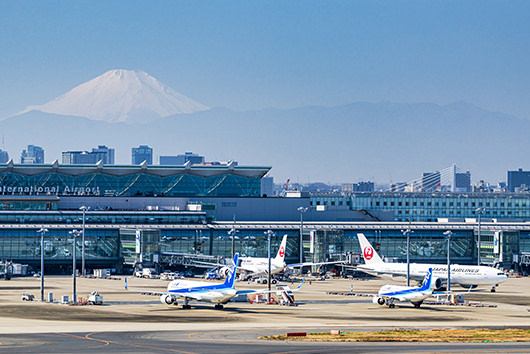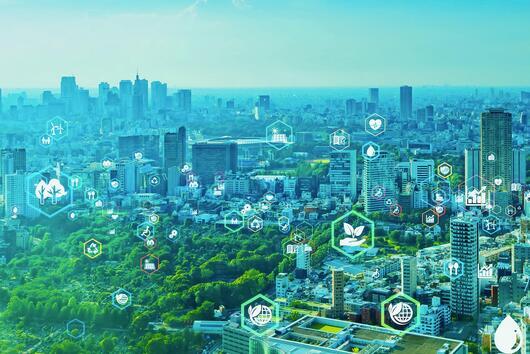The term as green infrastructure is becoming more common. Green infrastructure is the term refers to the idea and initiatives to utilize various functions and mechanisms of nature to create rich living spaces and prepare for disasters. However, the areas covered are extremely broad, ranging from urban areas to mountainous areas, and the content of the initiatives is diverse, making it not easy to get a concrete image of what it means. We interviewed Shogo OGASAWARA, Environmental Symbiosis Dept., Social Innovation Div. about what green infrastructure is and how it can be used.
INDEX
- What is Green Infrastructure? - Toward Collaboration between the Environment, Society, and Economy -
- Developing a Sustainable and Attractive National Land and Region
- Green Infrastructure Encompassing a Various Range of Initiatives
- Examples of Green infrastructure Initiatives
- PACIFIC CONSULTANTS' Initiatives
What is Green Infrastructure? - Toward Collaboration between the Environment, Society, and Economy -
The term as green infrastructure began to be used in the United States and Europe around 2010. In the United States, it is discussed from the perspective of rainy water management in urban areas, and efforts such as "rain gardens" have been attempted with the aim of reducing overflow from sewerage systems and reducing pollution caused by rainy water, etc. Meanwhile, in Europe, it is primarily defined as a strategic network of natural environments that provide ecosystem services such as water purification and recreation.
Although there are differences in their approaches, they are all based on the idea of re-examining the functions and values of nature, which have not previously been clearly recognized, and making active use of them.
In Japan, too, with the postwar economic growth and urban development, nature was often discussed in opposition to society/economy. Green infrastructure aims to link the functions of nature to social and economic development, and is an essential concept for creating a sustainable society through the collaboration of nature, society, and economy.
Developing a Sustainable and Attractive National Land and Region
In Japan, the promotion of green infrastructure was first set out in the "National Spatial Plan" (Ministry of Land, Infrastructure, Transport and Tourism) approved by the Cabinet in August 2015, and was described as "Initiative to Promote the Development of Sustainable and Attractive National Land, Cities and Regions by Utilizing the Diverse Functions of the Natural Environment in Both Hard and Soft Aspects such as Social Capital Development and Land Use, etc.". It was subsequently positioned in various higher-level plans for development of national land and regions, such as the "Basic Environment Plan" (Ministry of the Environment) and the "Basic Plan for National Resilience" (Cabinet Secretariat), and in 2023 the "Green Infrastructure Promotion Strategy 2023" (Ministry of Land, Infrastructure, Transport and Tourism Land, Infrastructure, Transport and Tourism) was formulated.
There are two main reasons for the demand for green infrastructure. One is the "Creation of Attractive Cities and Living Spaces". There is an increasing need for cities and living spaces where people can live healthy and high satisfying lives, such as promoting health and providing a good living and child-growing environment, and the concept of well-being is attracting attention. Green infrastructure, such as urban green spaces, is an important element that brings attractive and richness to living spaces. The other one is the "Responding to Recent Social Issues". Issues in developing sustainable regions, such as the increasing severity and frequency of natural disasters, aging infrastructure, and an increase in underutilized land due to population decline, have become apparent, and green infrastructure is attracting attention as one of the solutions to these social issues. It is expected that green infrastructure will be developed into an initiative with various effects, such as making good use of the functions of local nature and land, contributing to the formation of local communities by having citizens participate in maintenance and management on a daily basis, and demonstrating disaster prevention and mitigation functions in the event of a disaster.
Green Infrastructure Encompassing a Various Range of Initiatives
So what kind of initiatives are actually being implemented? There is no clear line between what is green infrastructure and what is not. A wide range of initiatives that utilize the functions of the natural environment from both the hard and soft aspects are being considered and implemented as green infrastructure.
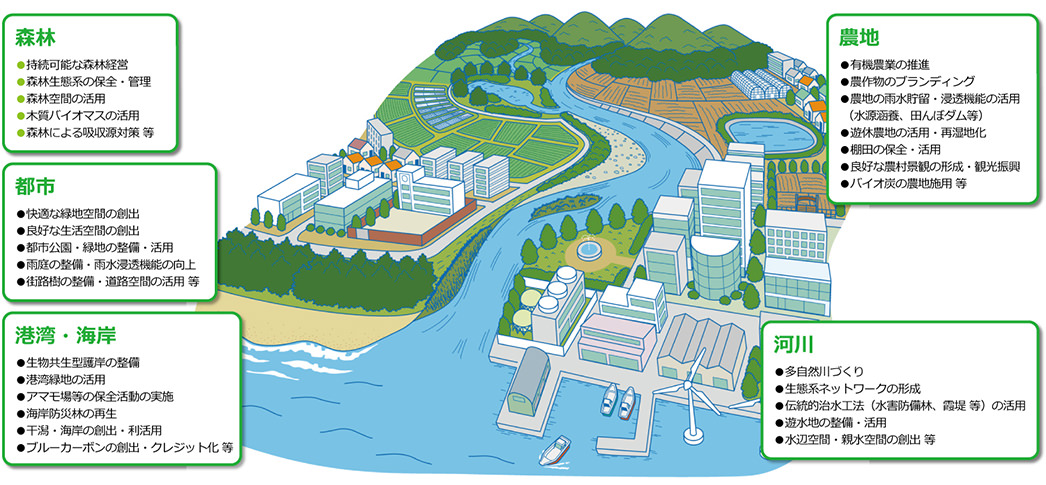
In 2023, the Ministry of Land, Infrastructure, Transport and Tourism published the "Green Infrastructure Practice Guide". Representative green infrastructure initiatives include the following:
| Area | Main Initiatives |
|---|---|
| Urban areas | Urban parks and green spaces, outdoor greening, rooftop and wall greening, street trees, greenways, rain gardens, green ditches (bioswells), bio-symbiotic port embankments, etc. |
| Suburban areas | Conservation and utilization of woodland and rural areas, urban farmland and community gardens, natural restoration of rivers, utilization of floodplains and underutilized spaces, etc. |
| Rural areas | Management and utilization of forests and farmland, utilization of abandoned forests and cultivated land, restoration of seaweed beds and tidal flats, etc. |
The key point is to comprehensively design these as initiatives that will bring about effects such as rainwater storage and infiltration, biodiversity conservation, and the creation of lively communities. Furthermore, by arranging these as a network within the community, rather than as independent initiatives, the effects can be more maximized. Green infrastructure is also a keyword for integrating important elements for developing attractive communities, such as greenery, water, and urban development.
Examples of Green Infrastructure Initiatives
Looking at the actual initiatives being undertaken by keywords related to green infrastructure, such as urban spaces, forest and farmland management, we find the following:
Urban Space
In urban areas, rainwater storage and infiltration measures such as rain gardens, are being implemented as a measure against inland flooding caused by torrential rains. The concept of rain gardens developed in the United States, was adapted as a Japanese version, and are becoming more widespread as a form of green infrastructure that can be involved with local governments and citizen groups.
Specifically, in public spaces such as parks and sidewalks, and private sites such as business premises, rainwater that falls on the ground is temporarily stored and slowly seeped into the ground, rather than being discharged directly into the sewer system. In addition to the expected effects of quality of purifying water and creating a habitat for living things, the design as garden also provides value as landscaping and greening that brings people peace of mind. For example, in the case of Kyoto City, rain gardens were installed at road intersections, with a structure that collects rainwater that falls on the paved surfaces of the roads, and the dry landscape gardens that make use of Kyoto's garden culture were used to consider the city's landscape.
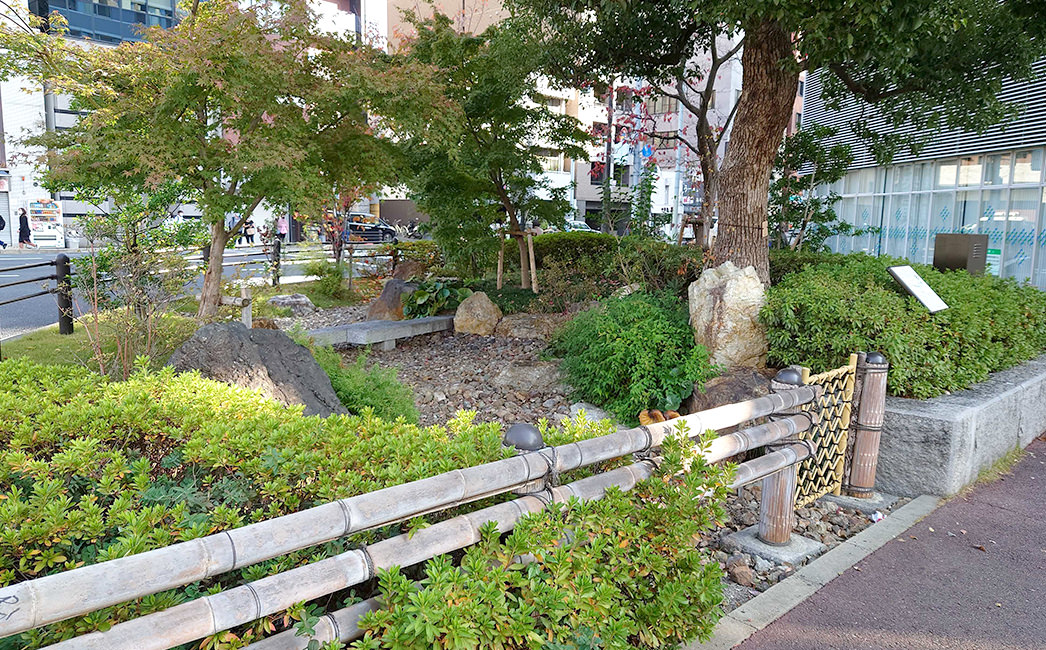
In urban areas, plantings around office buildings, urban green spaces such as roadside trees, and open spaces such as parks are also important components of green infrastructure. Large-scale green spaces are also being created in re-development projects, and there are an increasing number of examples where they are not only used as valuable open spaces in the city, but also utilize various natural functions in terms of quality, such as storing and infiltrating rainwater, creating cool spots, and preserving biodiversity, to provide comfortable spaces. Recently, "Grand Green Osaka" in the north area of Osaka Station has been attracting attention as a large-scale, high-quality green space in the city.
In addition, the Urban Green Space Conservation Act was revised, and the "Certification System for Securing Quantity and Quality Urban Green Space (TSUNAG)" will begin operation in November 2024. This system allows the Minister of Land, Infrastructure, Transport and Tourism to evaluate and certify initiatives by private business operators and others to secure high-quality green spaces from the perspective of "quality" such as measures against climate change, securing biodiversity, and improving well-being and "quantity" of green spaces. The operation of this system is expected to provide guidelines for promoting effective initiatives by private business operators and others to secure green spaces, as well as to lead to social and economic benefits by visualizing value.
The development of rain gardens and securing of green spaces in urban areas are all efforts aimed at contributing to the development of attractive and sustainable cities by making effective use of limited urban space. Going forward, there will be a need to continue to pool the wisdom of stakeholders including civic groups, private companies, and government agencies, and to continue to come up with new ideas.
Forest and Farmland Management
Even in mountainous and rural areas, forests and farmland are viewed as green infrastructure, and many initiatives are being made to maintain and utilize them as infrastructure that supports the region.
In the past, forests and grasslands were places for fuel and food production, and were closely linked to the lives and livelihoods of the local community. However, recently, with the spread of chemical fuels and fertilizers, their connection to daily life has weakened, and an increasing number of forests and grasslands are being left unused and degraded. On the other hand, these natural environments still support the region in terms of forming the landscape and maintaining the water cycle, and initiatives are being made to ensure that they continue to function as infrastructure. For example, it is said that artificial forests that are not managed, such as thinning, have a hard time allowing light to reach the ground surface, and the forest floor vegetation declines, resulting in a decline in the water source conservation function and soil retention capacity. Satoyama (managed woodlands or grasslands near human settlements) forests and grasslands also have various functions when managed by humans, but the lack of such connection in modern life is an issue. For this reason, initiatives are being made to utilize the functions of natural environments such as forests and meet modern needs.
The Forestry Agency has focused on the value of forest space, and is promoting its use as a place to provide experiences such as environmental education and forest bathing, which it calls the "Forest Service Industry". In addition, with the rise in social interest in carbon neutrality, attention has been focused on the carbon storage function of forests, and the amount of carbon absorption is increasingly being traded on the market as credits such as J-Credits.
Furthermore, farmland also has many functions beyond just producing food, such as preventing floods and conserving biodiversity. Abandoning farmland not only leads to the loss of these functions, but can also bring about new issues, such as the invasion of wild animals such as wild boars and illegal dumping of garbage. For this reason, it is necessary to re-consider idle farmland as green infrastructure for the region and draw out its functions beyond just food production. In the Inbanuma basin in Chiba Prefecture, initiatives are underway to restore wetlands on idle farmland and utilize functions such as water purification and biodiversity conservation, and these initiatives are spreading throughout the entire basin.
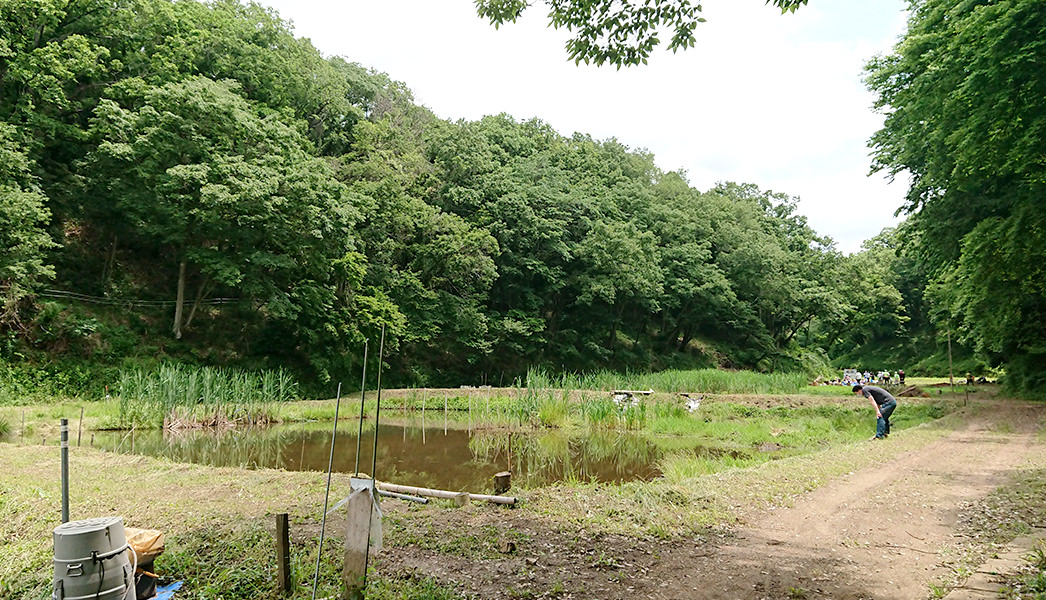
In this way, forests and farmland are important green infrastructure that support local communities. However, in order to utilize the diverse functions of green infrastructure, it is not appropriate to place the burden solely on the owners of the forests and farmland, given their public benefit. Therefore, it is necessary to re-evaluate them as local resources and develop them as initiatives involving various stakeholders, including public support.
River Basin for Flood Control
Due to the frequent occurrence of flooding and inundation damage caused by torrential rains, initiatives are underway to promote "River Basin for Flood Control" that involves all stakeholders in the river basin, from upstream to downstream, including residents, business operators, and government agencies, to promote flood prevention measures. In 2021, the "Act Related on River Basin for Flood Control" was also enacted. In promoting river basin for flood control, the idea of conserving and restoring ecosystems that also contribute to reducing disaster risks and forming ecosystem networks is also positioned, and green infrastructure has become a keyword for promoting comprehensive measures.
One example is a reservoir. A reservoir is a facility that reduces the amount of water flowing downstream by storing part of the river water when the river water level rises due to heavy rain. Not only it does function well during floods, but it is also a valuable space for living creatures to live and grow, so initiatives are being made to promote its use as a place for environmental education and a tourist base. In the Maizuru reservoir in Hokkaido, the reservoir is positioned as a new green infrastructure, and a council of local stakeholders is considering how to utilize it. In fact, red-crowned cranes have been spotted flying in and nesting there, and the council is trying to use the reservoir as a base for the region while protecting its environment. In addition, in the Asagi reservoir in Shizuoka Prefecture, the Asagi reservoir conservation and utilization promotion council was established, and the reservoir is being used as a place for agriculture and environmental education in cooperation with surrounding welfare and medical facilities and companies.
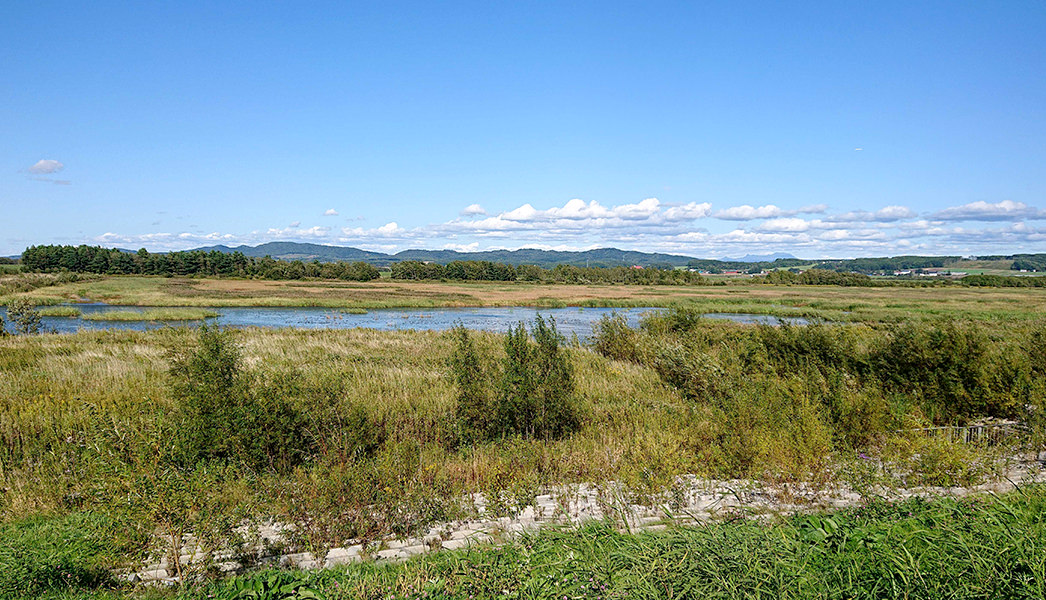
Furthermore, when we look at river basins, river basin for flood control initiatives also include the construction of "Rice Paddy Dams" to temporarily store water in rice paddies, and the development of forests to increase the infiltration and water retention capabilities of rainwater, which can be said to be attempts to utilize the functions of the natural environment.
In addition, the Ministry of the Environment will publish the "Guideline for Ecosystem-based Disaster Risk Reduction (Eco-DRR) for Sustainable Community Development" in 2023, and is promoting efforts to contribute to the compatibility of disaster risk reduction with biodiversity conservation. As social interest in nature positivity increases, the implementation of green infrastructure is expected from the perspective of biodiversity conservation and restoration.
PACIFIC CONSULTANTS' Initiatives
Green infrastructure is an important keyword when considering future land management and regional development in light of changing social issues such as population decline and climate change. Pacific Consultants, which has the vision of "Realizing a Prosperous Living Life without Threat or Disparity for Everyone in the World" and "Protecting the Beautiful Earth, the Source of All Life and its Environment, and Handing it Over to the Future," believes that promoting green PACIFIC CONSULTANTS is important to achieve this, and is working on various initiatives to advance regional implementation.
In order to promote green infrastructure in a region, it is important to first create a comprehensive strategy, and to do so, it is necessary to recognize the resources and issues in the region. It is also effective to visualize on a map where resources with potential for green infrastructure are located in the region. PACIFIC CONSULTANTS uses GIS (Geographic Information System) tools and other methods to overlay and visualize various information on a map, and based on that information, we support the formulation of local government plans such as master green plans and regional strategies of biodiversity, as well as corporate strategies.
In addition, due to the nature of green infrastructure, which covers a wide range of initiatives, local government initiatives are not limited to one area, but require collaboration between many areas, including the environment, parks and green spaces, roads, water supply and sewerage, education, and agriculture and forestry. Furthermore, collaboration with local business operators and citizens can lead to more widespread initiatives. For this reason, we also support the holding of study sessions and opinion exchange meetings with the aim of facilitating horizontal collaboration within the government and communicating with local business operators and citizens. In this way, we, as consultants, will contribute to the implementation of green infrastructure by getting involved from the outside.
Furthermore, in order to promote the implementation of green infrastructure in the region, support based on expertise in a wide range of fields is necessary. We have supported the formation of guidelines and manuals for Ministry of Land, Infrastructure, Transport and Tourism and the Ministry of the Environment. We also participate as researchers and research institutions in research projects on green infrastructure, such as the Research Institute for Humanity and Nature's Eco-DRR (Ecosystem-based Disaster Risk Reduction) project and the SIP Phase 3 "Collaboration Platform among Ministries and Agencies for Green Infrastructure to Evaluate the Development of Attractive National Lands, Cities and Regions". We would like to use the knowledge we have gained through these experiences, such as basic concepts on green infrastructure, advanced examples in the region, and the technologies necessary for regional implementation, to support the implementation of green infrastructure in local governments and companies.
Green infrastructure is a concept that actively utilizes the diverse functions of the natural environment, and requires that the natural environment be viewed as a resource and that a wide range of uses be promoted while taking into consideration its characteristics and points of note. In addition, from the initial concept, a comprehensive approach is required to consider how green infrastructure can be incorporated into government plans, how it can be utilized in business management, and how it can reflect the needs of the local community, and at the same time, technical considerations are also essential. We believe that PACIFIC CONSULTANTS' unique comprehensive strength, integration capabilities, and technical capabilities can play a major role.



